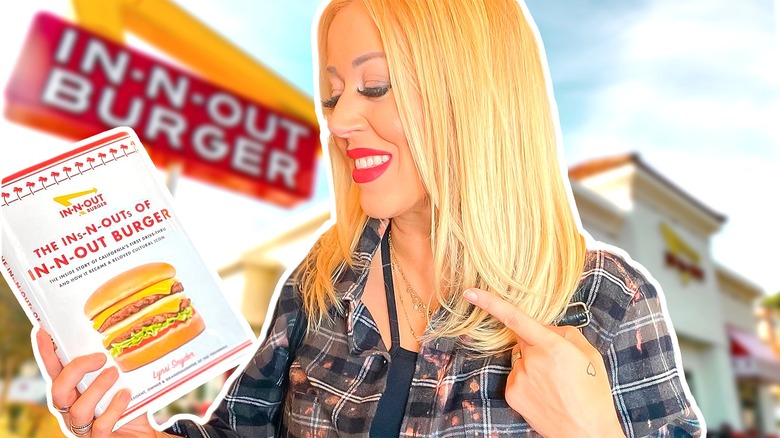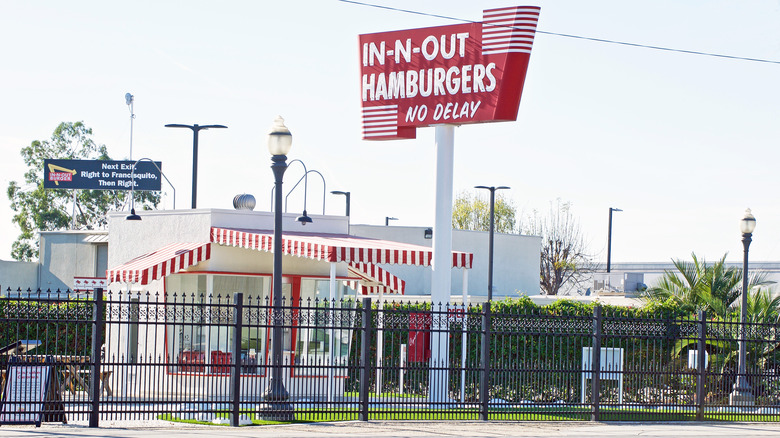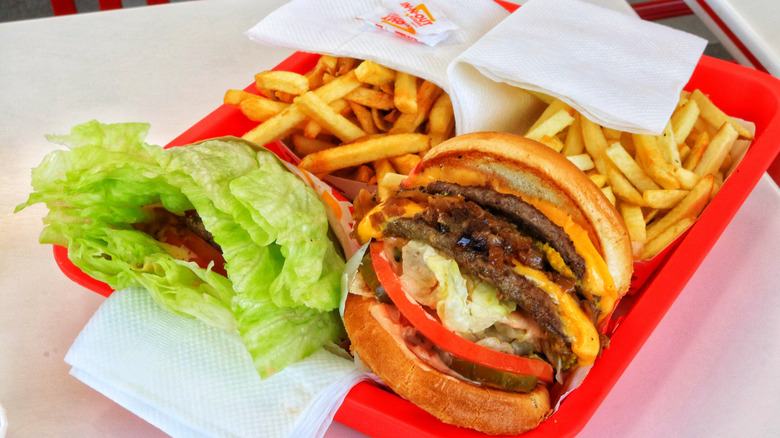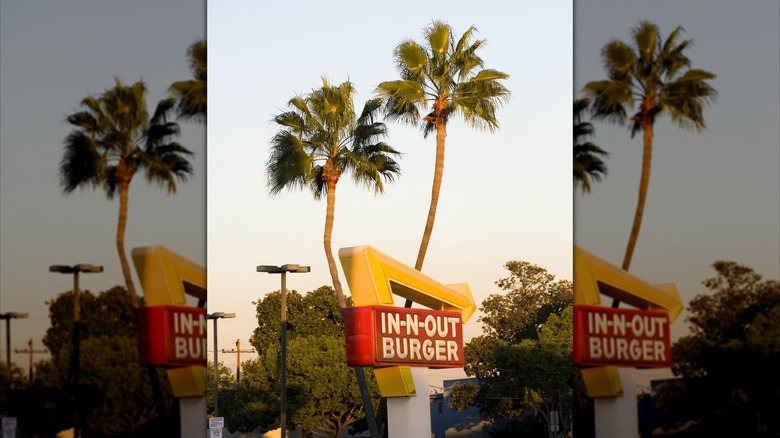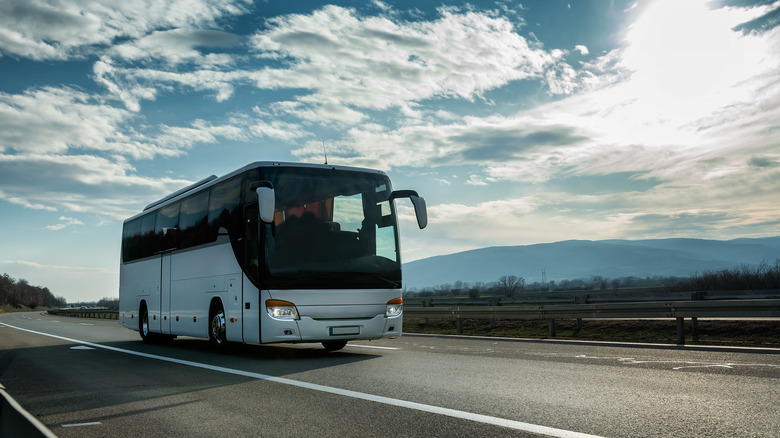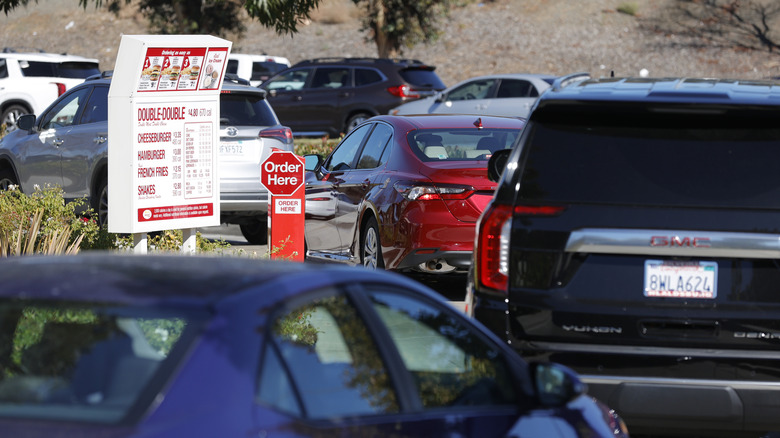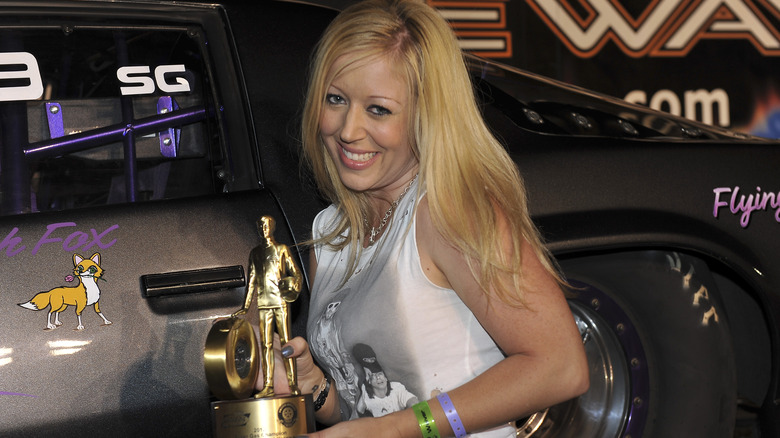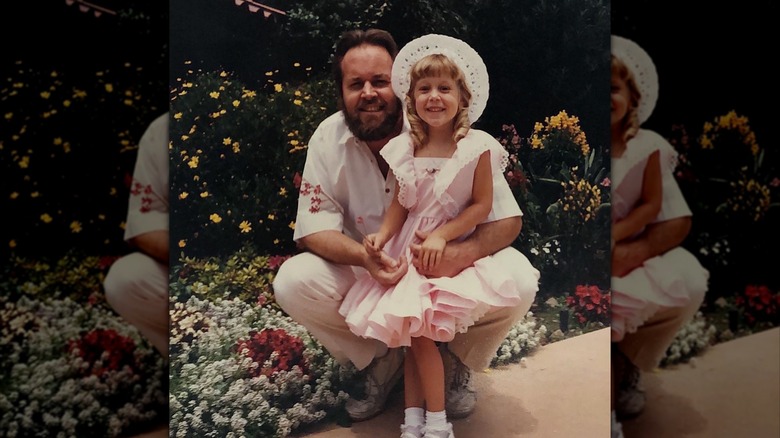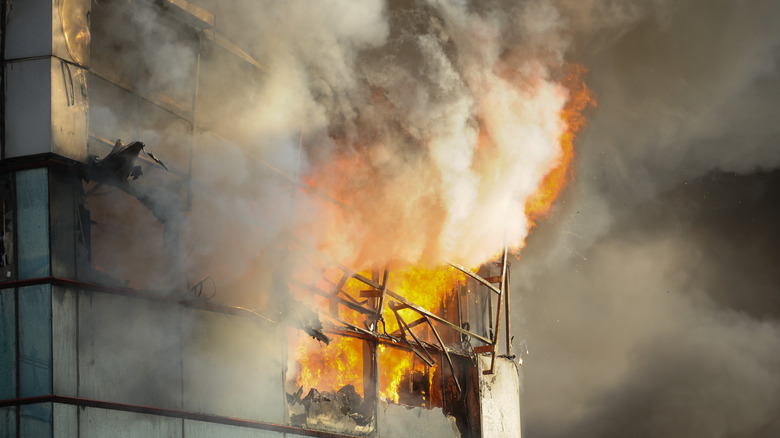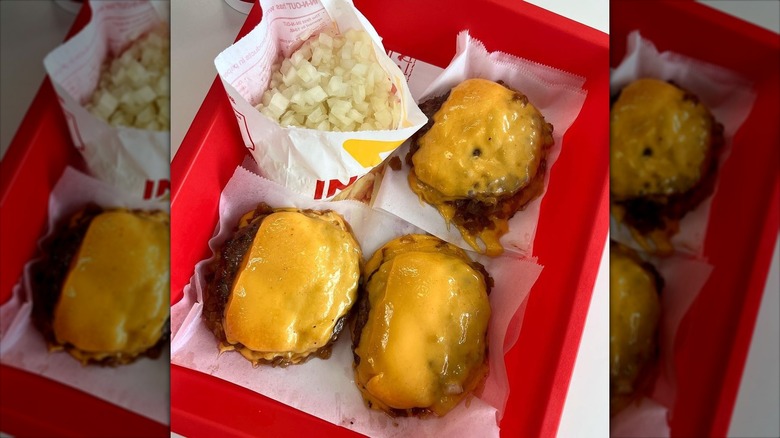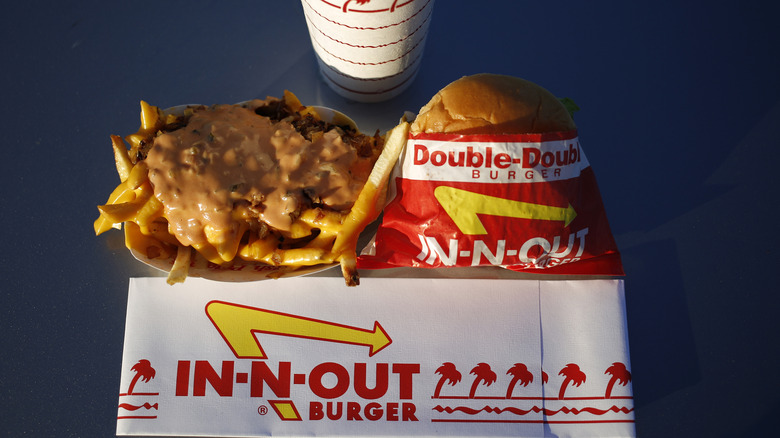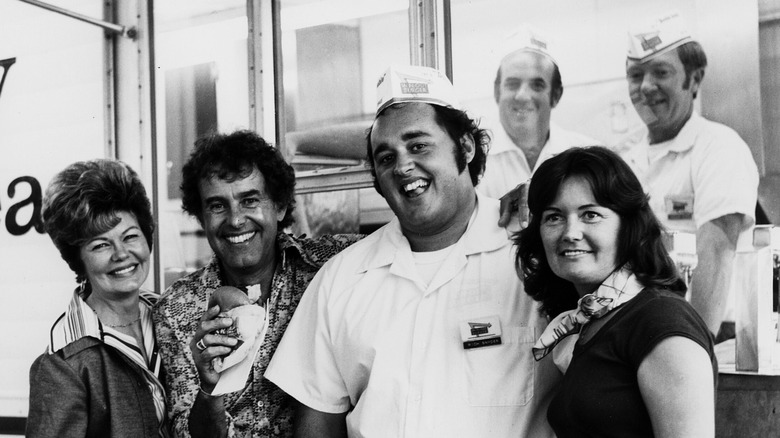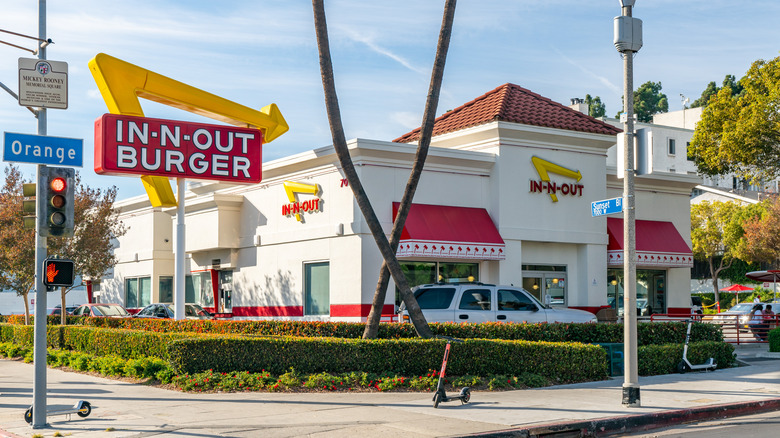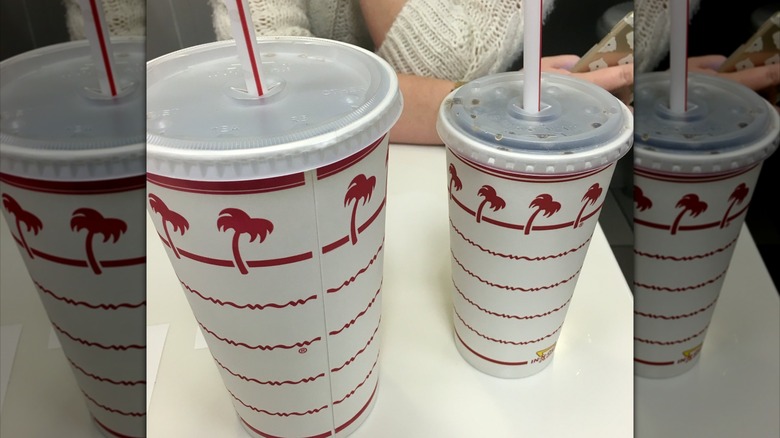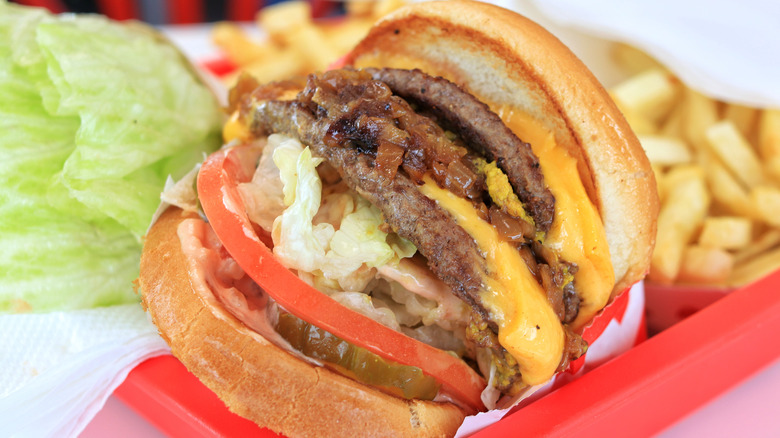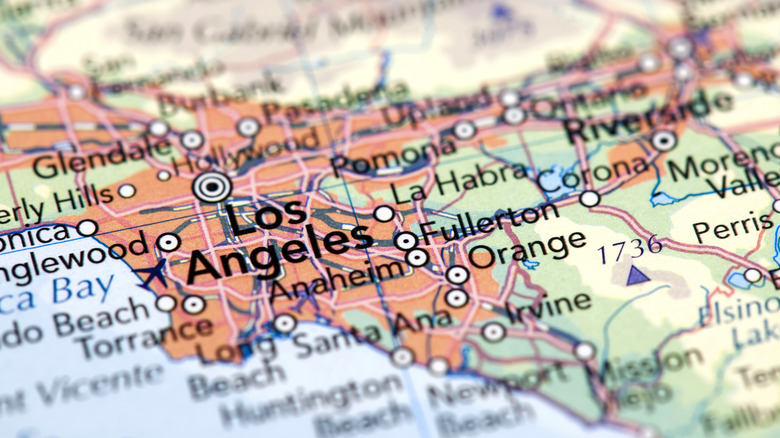15 Facts We Learned From In-N-Out President Lynsi Snyder's New Book
Though the iconic In-N-Out chain remains associated with its sunny California home, it has become famous throughout the country for the foods it does best: burgers, fries, and shakes. Passed down through three generations of the Snyder family, this once simple hamburger stand has grown into a massive company with branches in several states, yet it has never stopped providing the best in friendly service and delicious all-American fast food.
Current owner Lynsi Snyder, the only grandchild of the franchise's original founders, has written a book all about the company's inner workings, as well as her own family's history. Her perspective on watching the chain expand while growing up in the innovative and hard-working Snyder family is enlightening. The book is titled "The Ins-N-Outs of In-N-Out Burger," and it also includes a whole lot of the chain's secrets, family mysteries, and cool facts you probably never knew about In-N-Out.
We took a peek at the book and noted some of the most interesting facts we learned. We also found answers to long-standing questions about the chain's specials, history, and not-so-secret "secret" In-N-Out menu. If you're a fan of the burger chain or food history in general, you'll find these facts interesting, too.
The first In-N-Out was a 10-square-foot hamburger stand
The first In-N-Out was a 10-square-foot hamburger stand started in 1948 by Harry and Esther Snyder in Baldwin Park. At the time, Baldwin Park wasn't even an incorporated city, a far cry from the busy San Gabriel Valley community that exists there today. In the 1940s, the area was very rural, with dairy farms and orange groves dotting the landscapes. So, how was it selected for the first-ever In-N-Out location?
According to "The Ins-N-Outs of In-N-Out Burger," the Snyders saw a lot of former G.I.s and their families moving into the area in order to be able to commute to Los Angeles from a quieter (and cheaper) neighborhood. Harry Snyder thought that these commuters would want delicious food that they could order and pick up fast, as well as eat in the comfort of their cars. Turns out, he made a solid bet, as the small drive-thru stand sold over 2,000 burgers in its first month and became the first official store of the food giant now known as In-N-Out.
The Animal Style name comes from a rowdy bunch
In the early days of In-N-Out, young men and their dates, who were sometimes friends of workers in the store, would hang out in the parking lots. In true 1950s greaser style, they would play their music loudly, honk their horns, and generally cause a fun youthful ruckus. Helpers — what workers were called at the time — referred to them as "animals," generally in a somewhat playful way, according to Lynsi Snyder's "The Ins-N-Outs of In-N-Out Burger."
During this era, store manager Theo Roberts used to make himself a custom burger with pickles, grilled onion, and extra spread. One of the "animals" asked for it and then couldn't get enough of it, proceeding to ask for it every night. Eventually, it became so popular among this crowd that the order was nicknamed "Animal Style." Today, it remains one of the most beloved and popular items on In-N-Out's secret menu. You can also make pretty much anything Animal Style, including the store's fries, or opt for one of the many other modifiers and customizations that the In-N-Out secret menu sells.
The two crossed palm trees come from a 1960s movie
If you've stopped by an In-N-Out location lately, you've probably noticed the presence of two crossed palm trees planted right outside the building. A lot of locations across the country — and especially in the areas that are hospitable to palm trees — bear this marker. It's often made with two 20-foot Mexican fan palm trees artificially crossed at a height of 10 feet.
The palm tree symbol comes from the 1963 movie "It's a Mad, Mad, Mad, Mad World," which was a favorite of the founder and first CEO of In-N-Out, Harry Snyder. In the movie, the heroes have to look for buried treasure under four crossed palm trees. After enough In-N-Out stores had been opened and with advice from a restauranteur friend that the new chain needed some kind of recognizable symbol, Harry thought the crossed palm trees would be brilliant to draw a parallel to the movie. When you find the crossed palm trees, you find the treasure — an In-N-Out Burger.
Former CEO Rich Snyder worked out of a bus
As the son of Harry Snyder, Rich Snyder took over In-N-Out at the young age of 24 and brought a slightly different way of doing things. He was responsible for much of the company's expansion and innovations, like Burger Television (BTV), for which he put a production team together to create content for training and development.
In the '90s, In-N-Out had officially expanded to over 71 stores. Rich decided that instead of working in a lavish office, it would make more sense to operate out of an office on wheels as the head of a rapidly expanding chain. Rich commissioned a customized bus where he would take meetings with vendors and associates on the road. It enabled better face-to-face relations with important collaborators and employees. He would also stop and check in on stores, ensuring each location he visited was maintaining quality control and serving the best burgers possible.
Many of Rich's decisions revolved around centering associates and customers and providing a superior experience to them. In addition to the bus, he established a direct 1-800 line so customers could call In-N-Out and have their questions answered by someone with in-store experience. These days, a lot of questions concern whether new In-N-Out locations are about to be opened anywhere near a prospective customer's home, per "The Ins-N-Outs of In-N-Out Burger."
In-N-Out had the first ever drive-thru speaker
Harry Snyder ran into a few problems after launching his first drive-thru, especially when it came to communicating with customers in their cars. The driver or his passengers would have to get out of the car, go up to the window, order, and then wait for their food. This defeated part of the convenience of a drive-thru store, as theoretically, customers should never have to leave their car. In order to streamline this process, Harry thought back to his military days and remembered the speakers used in the army.
As a result, in July 1949, using some handyman knowledge, he installed what "The Ins-N-Outs of In-N-Out Burger" regards as the first-ever drive-thru two-way speakers. Considering no one had ever seen or used drive-thru speakers before, Harry had to make sure his customers knew what to do with them. That's why outside the first In-N-Out stand, he put up a sign that read "2-Way Speaker: For Your Convenience, Driver May Order Without Leaving Car." Harry correctly believed that commuters would want fast service in the comfort of their cars, and the success of In-N-Out confirmed his theory.
How car racing and In-N-Out became intertwined
Harry Snyder loved cars, and he would frequently take his sons to the Irwindale Drag Strip to spend quality time together watching the races. In fact, in 1965, he became part owner of the drag strip and set up two snack bars there that did amazingly well.
The family's appreciation for automobiles continued to grow after seeing all the classic cruisers driving through their stores every day. Both Guy and Rich would tinker with cars growing up, building them up and racing them. Since Guy got the nickname "Flying Dutchman" when Lynsi grew up, and it was time to choose a racing nickname for herself, she chose "Flying Dutch Fox" as a tribute to her father.
Several members of the family participated in drag racing, including current president Lynsi Snyder, per her book, "The Ins-N-Outs of In-N-Out Burger." The store itself is partnered with the Pomona Drag Strip. In fact, the chain's 70th and 75th anniversaries were both celebrated at the dragstrip. For the 70th anniversary in 2018, In-N-Out celebrated alongside Hot Rod magazine.
The founding family had some tragic secrets
Rich and Guy Snyder, the sons of founder Harry, started the Child Abuse Fund, which In-N-Out runs, just days after their father's death. Even though they loved their father, who had himself been the victim of childhood abuse, after his death, they also finally realized and openly talked about the fact that they had been abused as children. Though the brothers managed to stop the cycle of abuse — Guy was a very loving father to Lynsi — they both still had remaining trauma.
After raising his family and helping drive In-N-Out's success, Guy Snyder unfortunately fell into substance abuse towards the end of his life. This resulted in three separate overdoses in 1999 and his eventual death from an accidental overdose in 2000. Rich Snyder had a cleaner image in public, partly because of his fervent devotion to running In-N-Out, but according to Lynsi Snyder's book, he also struggled with a cocaine addiction while he served as CEO of the burger chain.
The intergenerational abuse the family lived with may have caused a lot of pain, but the fund they set up to help cope, heal, and disrupt the cycle of abuse from happening to others, lives on. The family changed the charity's name from the Child Abuse Fund to the In-N-Out Burger Foundation, and the organization continues to assist victims of child abuse with foster care placement, intervention, treatment, and emergency shelter.
A fire in 1978 almost shut In-N-Out down
In 1978, A USDA inspector had come by In-N-Out's headquarters and was reportedly working in his onsite office when, one day, he left a space heater on. This small heater ended up causing a huge fire at In-N-Out's primary warehouse, destroying tons of products and archives, as well as the space where workers prepared the chain's meat and spread. Unfortunately, this devastating fire occurred just 18 months after Rich Snyder assumed leadership, right as he was getting his footing.
However, with hard work, creative thinking, and loyal vendors, the family and company rallied. Rich proved his ability to lead by facing the problem head-on and working out deals with vendors, who rewarded the Snyder family's loyalty to them by rushing to replace damaged and lost inventory. Esther Snyder set up desks for the entire accounting team to come and work from her home. Eventually, the Snyders rebuilt the headquarters in Baldwin Park, and the company rebounded from this unexpected crisis it experienced at a vulnerable time.
The Flying Dutchman comes from racing
In-N-Out customers often wonder why one of the secret menu orders is called "The Flying Dutchman," a term usually associated with the legend of an old ghost ship. The truth, according to Lynsi Snyder's book, "The Ins-N-Outs of In-N-Out Burger," is that the Flying Dutchman got its name because it was Guy Snyder's favorite order. And also his racing nickname.
Guy was proud of his Dutch heritage, and thanks to his love of racing, he eventually became known as the Flying Dutchman when he showed up at the Irwindale Raceway. At the time, the company was still relatively small, and all the cooks (who were also managers then) knew Guy's order. Eventually, they just started calling it the Flying Dutchman. If you ask for one today, you will get the same combination of ingredients that Guy loved: two slices of cheese sandwiched between two burger patties. It's one of the most unique orders as there's no bun, no wrap, nothing at all besides the beef patties holding the cheese together — perfect for someone on an Atkins diet.
Why you'll find Bible verses printed on In-N-Out products
Family matriarch Esther Snyder was a particularly faithful woman and a devoted Christian. She raised her children to believe in God, and while the rest of the Snyder family members ended up believing or not believing to varying degrees, there's no doubt that religion informed the family's business practices. It also likely played a role in helping shape In-N-Out's charitable organizations, as well as its efforts to always give back to the community.
This is why if you look closely at the wrapper on your next In-N-Out burger, you may notice a Bible verse printed on it. Current CEO Lynsi Snyder is a devout Christian whose own faith helps guide her in leading the organization. There are a few different verses floating around, and the one you get usually depends on what you order. For example, Revelation 3:20 is on hamburger and cheeseburger bags, while Nahum 1:7 is on Double Double wrappers.
The CEO and Executive VP both died in a plane crash
On December 15, 1993, several of the top-level executives at In-N-Out, including owner Rich Snyder, took off in a private plane from Fresno to Los Angeles. The plane made a couple of stops before its scheduled arrival stop in Santa Ana; in La Verne, Esther Snyder chose to deplane since the airport was closer to her home. As the flight continued on its journey, making its final approach towards John Wayne Airport in Santa Ana, it was tragically caught in the wake of turbulence of a commercial airliner.
The disturbance was too much for the small plane. It crashed into the ground with no survivors. CEO Rich Snyder, executive VP Phil West, Jack Sims (a consultant and friend of Rich's), and the pilot and copilot were all killed. Snyder and West had actually never flown together before so as not to risk a potential accident affecting the entire management team. This day was the one exception. Despite his deep grief, Guy Snyder stepped up to take the reins of In-N-Out after his brother's death.
Lynsi Snyder hid her identity to start working at In-N-Out
The founding family of In-N-Out has always believed in the importance of working your way up and appreciating the duties and effort of every single member of the chain's family of workers. As Harry Snyder's only grandchild, Lynsi knew she was in line to take over the burger chain. However, she didn't want to simply be handed control of a business she had never fully worked in and understood.
So when Lynsi turned 17 in 1999, she applied to work at In-N-Out's brand-new Redding location while refusing to disclose who her father was and her relation to the chain's executives. Even though Guy offered to make a call and get her in, she politely declined and instead waited in line outside the store for two hours to fill out an application. She gradually worked her way through training and learned the ins and outs of working at an In-N-Out store, an experience that would end up informing her understanding of the company as well as what it takes to work in almost every role of each store.
The company switched to Coke because of Pepsi's broken promise
In-N-Out used to sell Pepsi products and had an agreement in place with the company to not compete with each other. That seemed to be fine until PepsiCo slowly started acquiring other fast food brands like Taco Bell, Pizza Hut, and KFC. Though some people at In-N-Out were concerned, including owner Rich Snyder, these national fast food chains weren't seen as direct competitors because of the food they served, so business relations with PepsiCo continued for a while.
However, after a while, PepsiCo also bought Hot 'n Now, a drive-thru burger restaurant that definitely felt like a direct competitor. In-N-Out voiced their concerns, and PepsiCo promised they wouldn't expand the chain to any locations where it would directly compete with In-N-Out locations. Unfortunately, it seems PepsiCo didn't stick to its word; just weeks later, it opened a Hot 'n Now store in Fresno, right where In-N-Out had announced a new location about to open. It was followed shortly by another store in Irvine and the ending of the business relationship. In-N-Out began serving Coca-Cola products.
The store has a fly-away burger for customers on the go
As part of the secret menu, you can order a burger you love with all the ingredients and condiments wrapped separately to be eaten later. This wonderful solution is understandably named the Fly-away Burger. It's for those traveling from the West Coast (or an In-N-Out state) to somewhere the burger chain doesn't exist, like the In-N-Out-less East Coast.
So, if you're leaving California, for example, you can order the ingredients of your favorite burger, and a store employee will give you everything separately. Most of the ingredients won't spoil for the few hours you will find yourself on the plane. Carry the burger components with you, then heat up and assemble everything when you land. This order is a great idea for those who want to take a little bit of In-N-Out with them and introduce it to a far-away friend who has never tried.
The first lap mats were also genius marketing tools
When In-N-Out first introduced lap mats, they were simply brown wax paper. The first store had easy access to this paper because it was the wrapping that its buns arrived in. The purpose of the lap mats was to prevent customers from staining their clothes, legs, or cars while eating juicy burgers in the comfort of their front seat.
According to "The Ins-N-Outs of In-N-Out Burger," in 1970, Harry Snyder ended up printing a map of Los Angeles on the mats, which featured the eight In-N-Out locations that were in the city at the time. Drivers would keep the mats in their cars to use as actual maps (as there was no GPS then), and every time they would be on the road and hungry ... they had a convenient map of the nearest In-N-Out locations right there. Thus, the lap mats inadvertently became one of the fledgling store's best marketing tools.
